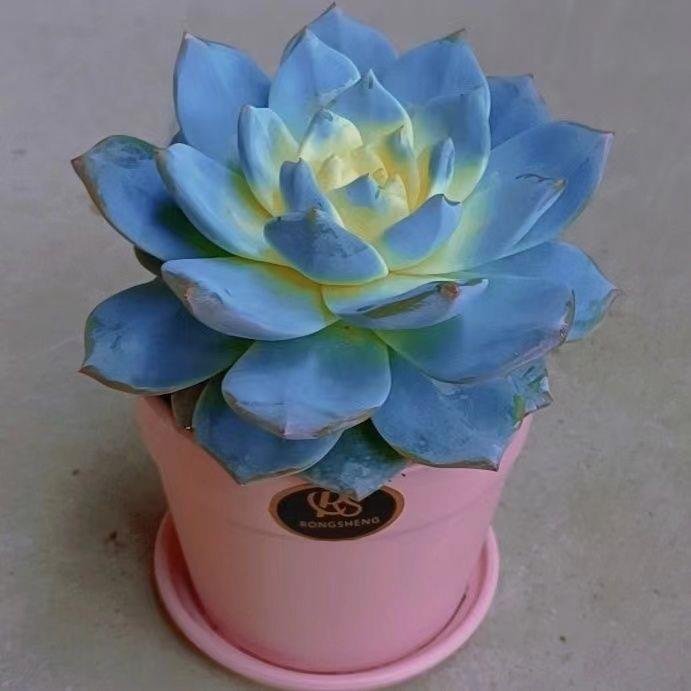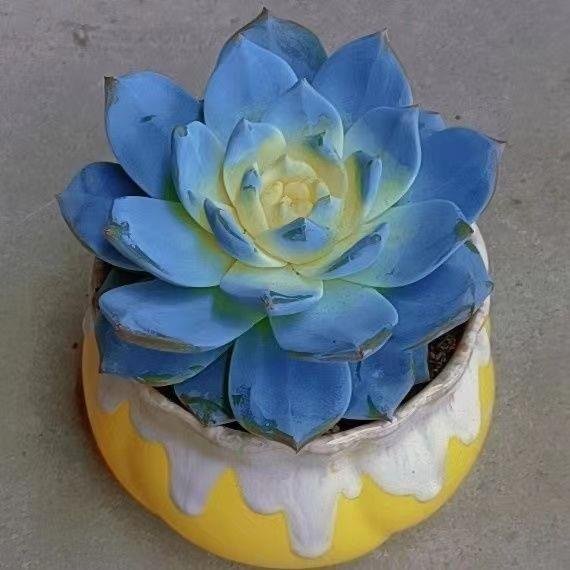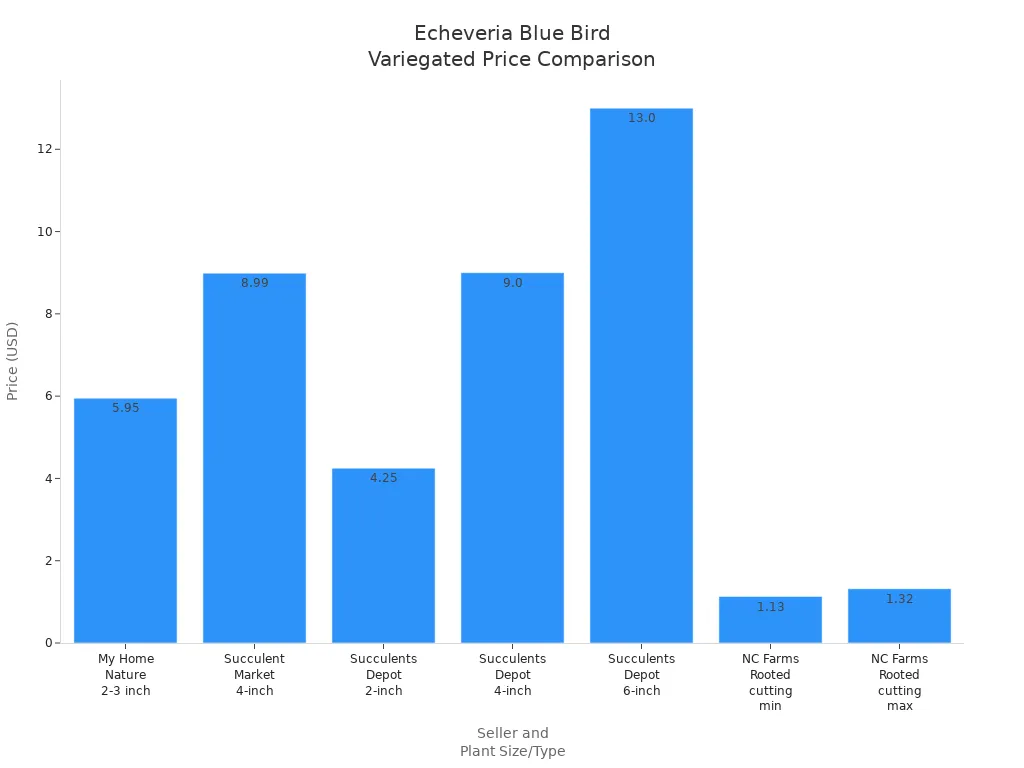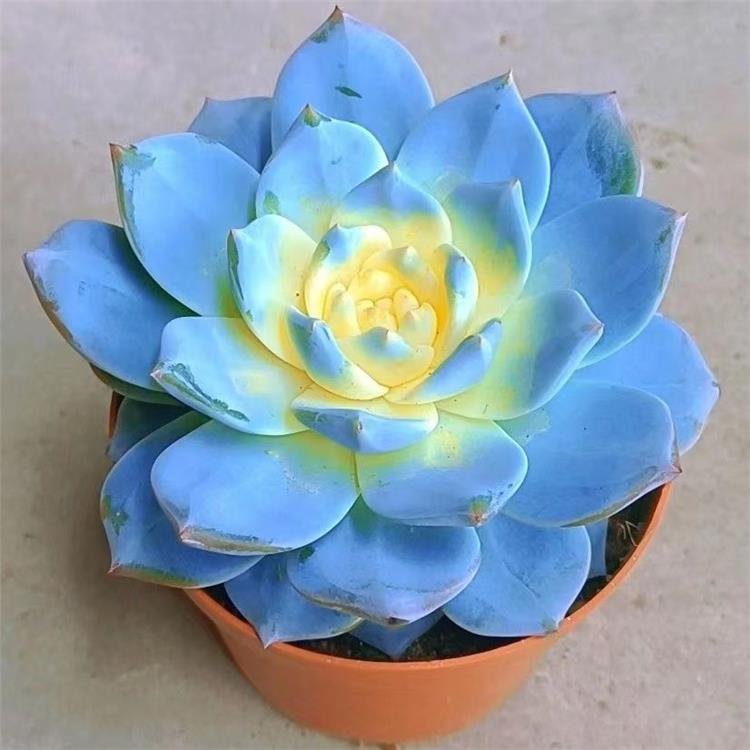
You might think the echeveria blue bird variegated is very beautiful. This plant has silvery-blue leaves with creamy patterns. Many collectors like how the blue mixes with the special streaks and spots. It is rare to see an echeveria with such bright colors. If you like growing plants that look different, this echeveria blue bird variegated could become your favorite.
Key Takeaways
- Echeveria Blue Bird variegated has silvery-blue leaves with creamy streaks. Each plant looks different and very pretty.
- Variegation is rare because it needs special genes. It is hard to keep when growing new plants from cuttings or seeds.
- This succulent needs soil that drains well, bright light, and careful watering. These things help it stay healthy and keep its bright colors.
- Collectors like this plant for its special look and slow growth. This makes it a prized and often costly plant to own.
- Watch for pests and do not overwater to stop problems like root rot and sunburn. This helps your plant grow well.
Echeveria Blue Bird Variegated

Unique Features
The echeveria blue bird variegated looks very different from others. It has special variegation that makes it stand out. Its leaves grow in a big, tight rosette, almost like a flower. The leaves are silvery-blue with creamy or yellow streaks and patches. These streaks can be on the edges or across the leaf. Each plant is unique because of these variegated spots. The tips of the leaves often turn pink. This happens more when the plant gets lots of sun or when it is cold. The pink color makes the echeveria blue bird variegated even prettier.
Variegation means some parts of the leaf do not have green pigment. You will see creamy, white, or yellow mixed with blue. This is because not all the plant’s cells make chlorophyll. Variegation is rare and makes the echeveria blue bird variegated special. No two plants look exactly the same, so collecting them is fun.
Tip: To spot a real echeveria blue bird variegated, check for a powdery layer on the leaves. This farina gives the plant a soft, frosted look. It also helps protect the plant from strong sunlight.
Color Patterns
The color patterns of the echeveria blue bird variegated are different from other types. You will see silvery-blue mixed with creamy variegation. The leaf tips turn pink, especially in fall and winter. The thick farina makes the leaves feel soft and velvety. This farina also helps the plant in full sun, acting like sunscreen.
Here is a table that shows how the blue bird echeveria compares to other types:
| Variety Name | Leaf Color and Pattern | Additional Characteristics |
|---|---|---|
| Blue Bird Echeveria | Large silvery blue rosette, bright pink margins in fall/winter, powdery farina | Rosettes up to 8-10 inches, loves sun or shade |
| Echeveria pulvinata | Fuzzy green leaves, red tips | Rosettes up to 6 inches, orange flowers |
| Echeveria ‘Topsy Turvy’ | Spoon-shaped blue-green leaves, curl upward | Whimsical leaf shape |
| Echeveria ‘Cubic Frost’ | Thick powdery lavender leaves | Geometric rosette form |
| Echeveria ‘Violet Queen’ | Pale blue-green leaves, pink tips | Tight rosettes up to 6 inches, sun or shade |
You can see the blue bird echeveria has a bigger rosette and a brighter blue color than most others. The variegated kind has creamy or yellow streaks, making it even more beautiful. Pink tips show up mostly when it is cooler, so the plant changes with the seasons. Many collectors like this.
When you take care of an echeveria blue bird variegated, you get a plant that looks like art. The mix of blue, cream, and pink always stands out. If you want a succulent that is special, this one is a great choice.
Why So Rare
Genetic Factors
You might wonder why you do not see many blue bird echeveria with variegation. The answer starts with genetics. Variegation in echeveria happens when some cells in the leaf do not make green pigment. This change is random and rare. Most blue bird echeveria grow with solid blue leaves. Only a few get the creamy or yellow patches that make them special. When you find a plant with this pattern, you know it is unique. The genes that cause variegation do not always pass to new plants. Even if you grow many blue bird echeveria from seeds, most will not show variegation. This makes the echeveria blue bird variegated very hard to find.
Note: Variegated plants often grow slower than normal ones. They have less green area to make food from sunlight.
Propagation Challenges
If you want to grow more blue bird echeveria with variegation, you will face some challenges. You cannot always make new variegated plants from seeds. Most growers use leaf cuttings or offsets. Even then, not every new plant keeps the variegation. Sometimes, the new growth turns all blue again. You need to watch each plant closely. If you see a leaf or stem turning back to solid blue, you must remove it. This helps keep the variegated look. Many growers lose variegation because it is unstable. The plant may change back to normal blue bird echeveria at any time. This makes it hard to keep a collection of variegated plants.
Here are some reasons why propagation is difficult:
- Variegated leaves may not root as easily.
- New growth can lose the creamy or yellow patches.
- Plants grow slower and need more care.
Market Demand
Collectors love blue bird echeveria with variegation. You will see high demand for these plants in both online and local markets. Many people want to add them to their collections because each one looks different. The rare color patterns make them stand out. When you try to buy one, you may notice the prices are higher than for regular blue bird echeveria.
Here is a table showing the price range for blue bird echeveria with variegation:
| Seller / Source | Plant Type / Size | Price Range (USD) |
|---|---|---|
| My Home Nature | 2-3 inch diameter pot | $5.95 |
| Succulent Market | 4-inch grower pot | $8.99 |
| Succulents Depot | 2-inch pot | $4.25 |
| 4-inch pot | $9.00 | |
| 6-inch pot | $13.00 | |
| North Carolina Farms, Inc. | Rooted cutting liners (per plug) | $1.13 – $1.32 |

You can see that prices go up with plant size. The rarest and most colorful blue bird echeveria often sell out fast. If you want to buy one, you need to act quickly. Many collectors watch for new listings every day. This high demand and low supply make the echeveria blue bird variegated even more special.
Special Appeal of Echeveria

Visual Interest
When you see an echeveria blue bird variegated, it looks beautiful right away. The leaves are soft blue-gray, which feels calm and peaceful. Each leaf has its own creamy or yellow streaks. These patterns make every plant look different from others. The leaf edges are a little ruffled, so they feel gentle to touch. The rosette shape is special because it looks like a flower. It can grow as wide as 10 inches.
Here is a table that shows what makes this echeveria so nice to look at:
| Feature | Description |
|---|---|
| Leaf Color | Blue-gray leaves with calm blue shades |
| Leaf Edges | Edges are a bit ruffled |
| Variegation | Each leaf has its own color pattern |
| Rosette Shape | Rosette shape is pretty and stands out |
| Size | Big rosettes, up to 10 inches wide |
| Contrast & Aesthetic | The colors and ruffled edges make it charming |
You can see how blue, cream, and pink mix to make strong contrast. Many people like to show this echeveria in their homes or gardens. It always catches the eye. The plant’s colors change with the seasons, so there is always something new to see.
If you want a succulent that looks like art, the echeveria blue bird variegated is a great pick.
Collector Value
Collectors look for rare plants that are easy to spot. The echeveria blue bird variegated is perfect for this. Its special variegation and big blue rosette make it a favorite for collections. Each plant has its own pattern, so no two are alike. This makes collecting them fun and interesting.
Many collectors like the challenge of finding and caring for these rare echeveria. The plant grows slowly and its colors change, which makes it even more special. When you add a blue bird variegated to your collection, it shows you love unique succulents. Some collectors trade or show their best plants at events. The echeveria blue bird variegated often becomes the star of any succulent display.
Blue Bird Echeveria Care
Identification Tips
You can spot a true blue bird echeveria by looking for a large, tight rosette with silvery-blue leaves. The leaves often have creamy or yellow streaks, which show the variegation. Pink tips may appear, especially when the weather gets cooler or the plant receives more sun. A powdery coating called farina covers the leaves, giving them a soft, frosted look. If you see these features, you likely have a blue bird echeveria variegated.
Tip: Check the leaf edges and the pattern of the variegation. Each plant has a unique mix of colors, so no two look exactly the same.
Basic Care
To help your echeveria thrive, focus on the right soil, light, and water needs. Use well-draining soil with at least 50% mineral grit, such as coarse sand, pumice, or perlite. This type of soil prevents water from sitting around the roots. You should place your plant in bright indoor light or full sun to keep its colors strong and the rosette compact. Water deeply but not often. Let the soil dry out completely before you water again. This method protects the roots from rot. During winter, space out watering even more because the plant grows slowly.
Here is a quick care table:
| Care Step | What to Do |
|---|---|
| Soil | Use cactus/succulent soil with 50-70% mineral grit |
| Light | Provide bright light or full sun |
| Water Needs | Water deeply, let soil dry fully between waterings |
| Fertilizer | Use well-rotted organic fertilizer sparingly |
Common Issues
You may face some problems while growing echeveria blue bird variegated. The most common pests are mealybugs, which hide in leaf crevices and look like white cotton. Remove them with an alcohol-dipped cotton swab or use insecticidal soap. Aphids can also attack, but you can control them with neem oil or insecticidal soap. Vine weevils chew on leaves and cause wilting. Pick them off by hand, especially at night.
Root rot is a big risk if the soil stays wet. Always use well-draining soil and avoid overwatering. Fungal diseases can appear if the air is too damp or the plant sits in water. Good air flow and proper watering help prevent this. Sunburn may cause brown spots if the plant gets too much direct sun. Move it to a spot with bright but gentle light if you see this.
Note: Watch for yellowing, browning, or drooping leaves. These signs mean your plant may need changes in care.
You now know why echeveria blue bird variegated stands out as a rare and loved succulent. Its unique colors and patterns make each plant special. Collectors value the challenge of finding and growing these beauties. When you follow the care summary, you help your plant thrive and keep its colors bright. Take time to enjoy and protect these living works of art.
FAQ
How can you tell if your Echeveria Blue Bird is variegated?
Look for creamy or yellow streaks on the blue leaves. Pink tips often appear in cooler weather. Each plant shows a unique pattern. A powdery coating called farina gives the leaves a frosted look.
Tip: No two variegated plants look exactly the same!
Why does your variegated Echeveria grow slower?
Variegated leaves have less green pigment. This means your plant makes less food from sunlight. You may notice slower growth compared to regular blue bird echeveria.
Can you grow a variegated Echeveria Blue Bird from seeds?
You usually cannot. Most seeds produce non-variegated plants. To keep the variegation, use leaf cuttings or offsets from a variegated parent.
What should you do if your plant loses its variegation?
Remove any leaves or stems that turn solid blue. This helps keep the variegated look. Give your plant bright light and proper care to encourage colorful growth.